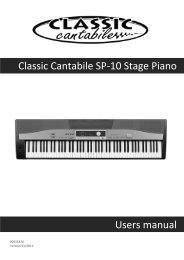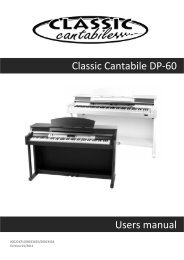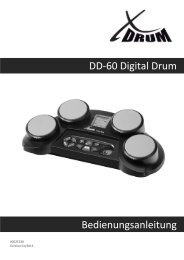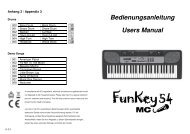Pronomic PMX-1804FX Users manual - Musikhaus Kirstein
Pronomic PMX-1804FX Users manual - Musikhaus Kirstein
Pronomic PMX-1804FX Users manual - Musikhaus Kirstein
You also want an ePaper? Increase the reach of your titles
YUMPU automatically turns print PDFs into web optimized ePapers that Google loves.
Disposal / WEE declaration<br />
Rechargeable Batteries and Batteries<br />
The supplied rechargeable batteries or batteries are recyclable. Please<br />
dispose of them at special waste collection points or your local dealer.<br />
Only dispose of exhausted batteries or rechargeable batteries to ensure<br />
environmental protection.<br />
WEEE-Declaration<br />
Your product is designed and manufactured with materials and<br />
components of high quality, which are recyclable and can be reused.<br />
The symbol means that your product should be disposed of separately<br />
from household waste when it reaches its end of life. Please dispose of<br />
this equipment at your local collection point or recycling center. Please<br />
help to protect the environment in which we all live.<br />
CE<br />
All specifications and appearances are subject to change without<br />
notice. All information was correct at time of printing. <strong>Musikhaus</strong> <strong>Kirstein</strong><br />
GmbH does not guarantee for the accuracy or completeness of any<br />
description, photograph or statement contained in this <strong>manual</strong>. Printed<br />
colors and specifications may vary slightly from product. Products from<br />
<strong>Musikhaus</strong> <strong>Kirstein</strong> GmbH are only sold through authorized dealer.<br />
Distributors and dealers are not agents of <strong>Musikhaus</strong> <strong>Kirstein</strong> GmbH<br />
and have no authority to bind <strong>Musikhaus</strong> <strong>Kirstein</strong> GmbH legally in any<br />
way. This <strong>manual</strong> is protected by copyright. Any copying or reprint, even<br />
in excerpts, is only allowed with written consent of <strong>Musikhaus</strong> <strong>Kirstein</strong><br />
GmbH. The same applies to reproduction or copying of images, even in<br />
altered form.<br />
00024066<br />
Version 01/2012<br />
<strong>Pronomic</strong> <strong>PMX</strong>-<strong>1804FX</strong><br />
<strong>Users</strong> <strong>manual</strong>
<strong>PMX</strong> Series Mixer<br />
Physical<br />
<strong>PMX</strong>1204FX<br />
Dimensions (H x W x D) 251 x 324 x 89 mm<br />
3.5 kg<br />
weight (net)<br />
18<br />
<strong>PMX</strong>1404FX<br />
Dimensions (H x W x D) 312 x 324 x 102 mm<br />
weight (net)<br />
5.5 kg<br />
<strong>PMX</strong>1604FX<br />
Dimensions (H x W x D) 365 x 324 x 102 mm<br />
weight (net)<br />
5.8 kg<br />
<strong>PMX</strong><strong>1804FX</strong><br />
Dimensions (H x W x D) 418 x 324 x 102 mm<br />
weight (net)<br />
6.4 kg<br />
Output Power<br />
<strong>PMX</strong>1204FX<br />
2 x 100W<br />
<strong>PMX</strong>1404FX<br />
2 x 300W<br />
<strong>PMX</strong>1604FX<br />
2 x 300W<br />
<strong>PMX</strong><strong>1804FX</strong> 2 x 300W<br />
THD+N +A<br />
<strong>PMX</strong>1204FX<br />
<strong>PMX</strong>1404FX<br />
<strong>PMX</strong>1604FX<br />
<strong>PMX</strong><strong>1804FX</strong><br />
S/N +A<br />
<strong>PMX</strong>1204FX<br />
<strong>PMX</strong>1404FX<br />
<strong>PMX</strong>1604FX<br />
<strong>PMX</strong><strong>1804FX</strong><br />
0.5%<br />
0.1%<br />
0.1%<br />
0.1%<br />
> 80 dB<br />
> 80 dB<br />
> 80 dB<br />
> 80 dB<br />
Frequency 20Hz-20KHz (+0, -1dB)<br />
Measuring conditions:<br />
1: 1kHz rel.to 0 dBu; 20 Hz - 20 kHz, line input; main output; unity gain.<br />
2: 20Hz - 20kHz; measured at main output. Channels 1 - 4 unity gain: EQ flat; all channels on main mix;<br />
channels 1/3 as far left as possible, channels 2/4 as far right as possible. Reference = +6 dBu.<br />
IMPORTANT SAFETY SYMBOLS<br />
The symbol is used to indicate that some hazardous live terminals are<br />
involved within this apparatus, even under the normal operating conditions,<br />
which may be sufficient to constitute the risk of electric shock or death.<br />
The symbol is used in the service documentation to indicate that specific<br />
component shall be replaced only by the component specified in that<br />
documentation for safety reasons.<br />
Protective grounding terminal<br />
Alternating current/voltage<br />
Hazardous live terminal<br />
ON: Denotes the apparatus is turned on<br />
OFF: Denotes the apparatus is turned off.<br />
WARNING: Describes precautions that should be observed to prevent the danger<br />
of injury or death to the operator.<br />
CAUTION: Describes precautions that should be observed to prevent danger of<br />
the apparatus.<br />
IMPORTANT SAFETY INSTRUCTIONS<br />
·Read these instructions.<br />
·Keep these instructions.<br />
·Heed all warning.<br />
·Follow all instructions.<br />
CAUTION<br />
RISK OF ELECTRIC SHOCK<br />
DO NOT OPEN<br />
· Water & Moisture<br />
The apparatus should be protected from moisture and<br />
rain, can not used near water, for example: near bathtub,<br />
kitchen sink or a swimming pool, etc.<br />
·Heat<br />
The apparatus should be located away from the heat source such as radiators,<br />
stoves or other appliances that produce heat.
·Ventilation<br />
Do not block areas of ventilation opening. Failure to do could result in fire. Always<br />
install accordance with the manufacturer's instructions.<br />
·Object and Liquid Entry<br />
Objects do not fall into and liquids are not spilled into the inside of the apparatus<br />
for safety.<br />
·Power Cord and Plug<br />
Protect the power cord from being walked on or pinched particularly at plugs, convenience<br />
receptacles, and the point where they exit from the apparatus.<br />
Do not defeat the safety purpose of the polarized or grounding-type plug. A polarized<br />
plug has two blades with one wider than the other. A grounding type plug<br />
has two blades and a third grounding prong. The wide blade or the third prong is<br />
provided for your safety. If the provided plug does not fit into your outlet, refer to<br />
electrician for replacement.<br />
·Power Supply<br />
The apparatus should be connected to the power supply only of the type as marked<br />
on the apparatus or described in the <strong>manual</strong>. Failure to do could result in damage<br />
to the product and possibly the user.<br />
Unplug this apparatus during lightning storms or when unused for long periods<br />
of time.<br />
·Fuse<br />
To prevent the risk of fire and damaging the unit, please use only of the recommended<br />
fuse type as described in the <strong>manual</strong>. Before replacing the fuse, make<br />
sure the unit turned off and disconnected from the AC outlet.<br />
·Electrical Connection<br />
Improper electrical wiring may invalidate the product warranty.<br />
·Cleaning<br />
Clean only with a dry cloth. Do not use any solvents such as benzol or alcohol.<br />
·Servicing<br />
Do not implement any servicing other than those means described in the <strong>manual</strong>.<br />
Refer all servicing to qualified service personnel only.<br />
·Only use accessories/attachments or parts recommended by the manufacturer.<br />
·Warning<br />
Please remember the high sound pressure do not only temporarily damage your<br />
sense of hearing, but can also cause permanent damage. Be careful to select a<br />
suitable volume.<br />
Aux sends<br />
Type<br />
Impedance<br />
Max.output level<br />
Stereo aux return<br />
Type<br />
Impedance<br />
Max.input level<br />
Main outputs<br />
Type<br />
Impedance<br />
Max.output level<br />
Control room outputs<br />
Type<br />
Impedance<br />
Max.output level<br />
Headphones output<br />
Type<br />
Max.output level<br />
DSP<br />
Converter<br />
Sampling rate<br />
2<br />
Main mix system data<br />
Noise<br />
Main mix @ -∞,<br />
Channel fader -∞<br />
Main mix @ 0 dB,<br />
Channel fader -∞<br />
Main mix @ 0 dB,<br />
Channel fader @ 0 dB<br />
Power supply<br />
<strong>PMX</strong>1204FX<br />
Mains voltage<br />
Power consumption<br />
Fuse<br />
Mains connection<br />
<strong>PMX</strong>1404FX/<strong>PMX</strong>1604FX/<strong>PMX</strong><strong>1804FX</strong><br />
Mains voltage<br />
Power consumption<br />
Fuse<br />
Mains connection<br />
<strong>PMX</strong> Series Mixer<br />
1/4" T S connector, unbalanced<br />
approx. 20 k Ω<br />
+22 dBu<br />
1/4" TRS connector, electronically balanced<br />
approx. 20 k Ω bal. /10 k Ω unbal.<br />
+22 dBu<br />
XLR electronically balanced<br />
approx. 240 Ω bal./ 120 Ω unbal.<br />
+28 dBu<br />
1/4"TS connector, unbal.<br />
approx. 120 Ω<br />
+22 dBu<br />
1/4" TRS connector, unbalanced<br />
+19 dBu / 150 Ω(+25<br />
dBu)<br />
24-bit Texas Instruments<br />
24-bit Sigma-Delta.<br />
64/128-times oversampling<br />
40 kHz<br />
-105 dB / -108 dB A-weighted<br />
-95 dB / -97 dB A-weighted<br />
-82.5 dB / -85 dB A-weighted<br />
100 -240 V~, 50/60 Hz<br />
200 W<br />
100 -240 V~, T10AH 250V<br />
Standard IEC receptacle<br />
100-240 V~, 50/60 Hz<br />
1000 W<br />
100-120V, T10AH<br />
200-240V, T5AH<br />
Standard IEC receptacle<br />
17
<strong>PMX</strong> Series Mixer<br />
16<br />
5.SPECIFICATIONS<br />
Mono inputs<br />
Microphone inputs (XENYX Mic Preamp)<br />
Type XLR, electronically balanced,<br />
discrete input circuit<br />
Mic E.I.N. (20 Hz - 20 kHz)<br />
@ 0 Ω source resistance<br />
@ 50 Ω source resistance<br />
@ 150 Ω source resistance<br />
-134 dB / 135.7 dB A-weighted<br />
-131 dB / 133.3 dB A-weighted<br />
-129 dB / 130.5 dB A-weighted<br />
Frequency response
<strong>PMX</strong> Series Mixer<br />
1.INTRODUCTION<br />
Congratulations! In purchasing the MX you have acquired a mixer whose small size belies its<br />
incredible versatility and audio performance.<br />
The MX Series represents a milestone in the development of mixing console technology. With the new<br />
microphone preamps including phantom power as an option. Balanced line input and a powerful effects<br />
section. The mixing consoles in the MX Series are optimally equipped for live and studio applications.<br />
Owing to state-of-the-art circuitry your MX console produces a warm analog sound that is unrivalled.<br />
With the addition of the latest digital technology these base-in-class consoles combine the advantages<br />
of both analog and digital technology.<br />
The microphone channels feature high-end Mic Preamps that compare well with costly outboard<br />
preamps in terms of sound quality and dynamics and boast the following features.<br />
* 130dB dynamic range for an incredible amount of headroom<br />
* A bandwidth ranging from below 10Hz to over 200kHz for crystal-clear reproduction of over the finest<br />
nuances.<br />
* The extremely low-niose and distortion-free circuitry guarantees absolution natural and transparent<br />
signal reproduction.<br />
* They are perfectly matched to every conceivable microphone with up to 60 dB gain and +48 volt<br />
phantom power supply.<br />
* They enable you to use the greatly extended dynamic range of your. 24-bit/192kHz HD recorder to<br />
the full. Thereby maintaining optimal audio quality.<br />
“Bitish EQ”<br />
The equalizers used for the MX Series are based on the legendary circuitry of top-notch consoles<br />
made in Britain, which are renowned throughout the world for their incredibly warm and musical sound<br />
character. Even with extreme gain settings these equalizers ensure outstanding audio quality.<br />
Mutil-effects processor<br />
Additionally, your <strong>PMX</strong> Series mixing consoles has an effects processor with 24-bit A/D and D/A converters<br />
included, which gives you 100 presets producing first-class reverb, delay and modulation effects<br />
plus numerous multi-effects in excellent audio quality.<br />
The <strong>PMX</strong> Series mixing consoles are equipped with a state-of-the-art switched-mode power supply<br />
(SMPS). Unlike conventional circuitry an SMPS provides an optimum supply current regardless of the<br />
input voltage. And thanks to its considerably higher efficiency a switched-mode power supply uses less<br />
energy than conventional power supplies.<br />
USB/Audio interface<br />
The USB interface supplied with the unit is a perfect match for the <strong>PMX</strong> Series and serves as a<br />
powerful recording interface to you PC or MAC. It supports the digital transmission of signals on up to<br />
four channel with max 48kHz and extremely low latency. When wired to the CD/TAPE INPUT and<br />
OUTPUT connectors, the interface transfers the stereo mix from the console directly to a computer. Both<br />
the recording signals and the playback signal from the computer can be monitored at the same time. In<br />
this way, you can use several recording runs to produce complete multi-track recordings.<br />
We should like to draw your attention to the fact that extreme volumes may damage your<br />
hearing and/or your headphones or loudspeakers. Turn the MAIN MIX faders and phones<br />
control in the main section fully down before you switch on the unit. Always be careful to<br />
set the appropriate volume.<br />
2<br />
strain relief clamp<br />
sleeve<br />
strain relief clamp<br />
Balanced use with XLR connectors<br />
2<br />
3<br />
1<br />
tip<br />
The foot switch connects the two poles momentarily<br />
sleeve<br />
ring<br />
tip<br />
1=groud / shield<br />
2=hot (+ve)<br />
3=cold (-ve)<br />
For unbalanced use pin 1 and pin 3 have to be bridged<br />
Unbalanced use of<br />
1/4"T RS connector<br />
sleeve tip<br />
ground shield signal<br />
Balanced use of<br />
1/4"T RS connector<br />
sleeve tip<br />
ground shield hot (+ ve)<br />
ring<br />
cold (- ve)<br />
1 2<br />
3<br />
Input Output<br />
For connection of balanced and unbalanced plus,<br />
rig and sleeve have to be bridged at the stereo plug<br />
strain relief clamp<br />
sleeve<br />
ring<br />
tip<br />
Headphones connection<br />
with 1/4" TRS connector<br />
sleeve tip<br />
ground shield left signal<br />
ring<br />
right signal<br />
<strong>PMX</strong> Series Mixer<br />
Fig. 4.2: XLR connections<br />
Fig. 4.3: 1/4" TS connector<br />
Fig. 4.4: 1/4" TRS connector<br />
Fig. 4.5: 1/4" TRS connector for<br />
headphones<br />
15
<strong>PMX</strong> Series Mixer<br />
This also goes for mixing effects signals with the monitor mix. The main difference is that the mix radio<br />
is adjusted using the FX TO MON control. Of course, a signal has to be fed into the efects processor via<br />
the FX control in the channel strip for both applications.<br />
On the following page, you will find an illustration showing how to connect your foot switch<br />
correctly.<br />
LEVEL<br />
The LED level mater on the effects module should display a suficiently high level. Take care to ensure<br />
that the clip LED only lights up at peak levels. If it is lit constantly, you are overloading the effects processor<br />
and this could cause unpleasant distortion. The FX control (AUX SEND 2) determines the level that reaches<br />
the effects module.<br />
PROGRAM<br />
You can select the effect preset by turning the PROGRAM control. The display flashes the number of<br />
the current preset. To recall the selected preset, press the button; the flashing stops. You can also recall<br />
the selected preset with the foot switch.<br />
14<br />
4.INSTALLATION<br />
4.1 Rack mounting<br />
The packing of your mixing console contains two 19 " rack mount wings which can be installed on the<br />
side panels of the console.<br />
Before you can attach the rack mount wings to the mixing console, you need to remove the screws<br />
holding the left and right side panels. Use these screws to fasten the two wings onto the console, being<br />
careful to note that each wing fits a specific side. With the rack mount wing installed. You can mount the<br />
mixing console in a commercially available 19" rack. Be sure to allow for proper air flow around the unit,<br />
and do not place the mixing console close to radiators or power amps. So as to avoid overheating.<br />
Only use the screws holding the mixing console side panels to fasten the 19" rack mounts.<br />
4.2 Cable connections<br />
You will need a larger number of cable for the various connections to and from the console. The<br />
illustrations below show. The wing of these cables. Be sure to use only high-grade cable.<br />
4.2.1 Audio connections<br />
Please use commercial RCA cables to wire the 2-track inputs and outputs.<br />
You can, of course, also connect unbalanced devices to the balanced input/outputs. Use either mono<br />
plugs, or ensure that ring and sleeve are bridged inside the stereo plug (or pins 1 & 3 in the case of XLR<br />
connectors).<br />
Caution! You must never use unbalanced XLR connectors (pin 1 and 3 connected) on the MIC<br />
inputs if you in tend to use the phantom power supply.<br />
1/4" TS connector for use with foot switch<br />
strain relief clamp<br />
sleeve<br />
tip<br />
sleeve<br />
pole 1/ground pole 2<br />
tip<br />
The foot switch connects the two poles momentarily<br />
Fig. 4.1: 1/4" TS connector<br />
for foot switch<br />
A mixing console fulfils three main functions:<br />
1.1 general mixing console functions<br />
*Signal processing: Preamplification, level adjustment, mixing of effects. Frequency equalization.<br />
*Signal distribution: Summing of signals to the aux sends for effects processing and monitor mix,<br />
distribution to one or several recording tracks, power amp(s), control room and 2-track outputs.<br />
*Mix: Setting the volume level, frequency distribution and positioning of the individual signals in the<br />
stereo field, level control of the total mix to match the recording devices/crossover/power amplifier(s).<br />
All other mixer functions can be included in this main function.<br />
The interface of LONGERDB mixing consoles is optimized for these tasks enabling you to easily keep<br />
track of the signal path.<br />
1.2 The user’s <strong>manual</strong><br />
The user’s <strong>manual</strong> is designed to give you both an overview of the controls, as well as detailed information<br />
on how to use them. In order to help you understand the links between the controls, we have arranged<br />
them in groups according to their function.<br />
1.3 Before you get started<br />
1.3.1 Shipment<br />
Your mixing console was carefully packed in the factory to guarantee safe transport. Nevertheless, we<br />
recommend that you careful examine the packing and its contents for any signs of physical damage. Which<br />
may have occurred during transit.<br />
If the unit is damaged, please do NOT return it to us, but notify your dealer and the shipping<br />
company immediately, otherwise claims for damage or replacement may not be granted.<br />
1.3.2 Initial operation<br />
Be sure that there is enough space around the unit for cooling purposes and to avoid over-heating please<br />
do not place your mixing console on high-temperature devices such as radiators or power amps. The<br />
console is connected to the mains via the supplied cable. The console meets the required safety standards.<br />
Blown fuses must only be replaced by fuses of the same type and rating.<br />
Please note that all unit must be properly grounded. For your own safety, you should never<br />
remove any ground connectors from electrical devices or power cables, or render them<br />
inoperative.<br />
Please sure that only qualified people install and operate the mixing console. During installation<br />
and operation, the user must have sufficient electrical contact to earth, otherwise<br />
electrostatic discharges might affect the operation of the unit.<br />
2.CONTROL ELEMENTS AND<br />
CONNECTORS<br />
<strong>PMX</strong> Series Mixer<br />
This chapter describes the various control elements of your mixing console. All controls, switches and<br />
connectors will be discussed in detail.<br />
3
<strong>PMX</strong> Series Mixer<br />
LINE IN<br />
MIC<br />
+10 +10 -40 +60<br />
TRIM<br />
dB/dBu<br />
0<br />
-15 +15<br />
0<br />
-15 +15<br />
0<br />
-15 +15<br />
BAL<br />
OR<br />
UNBAL<br />
LOW CUT<br />
75Hz<br />
18 dB/Oct<br />
Fig. 2.1: Connectors and<br />
controls of mic/line inputs<br />
EQ<br />
HIGH<br />
12 KHz<br />
MID<br />
2.5 KHz<br />
LOW<br />
80 Hz<br />
1<br />
MIC<br />
2.1 Mono channels<br />
2.1.1 Microphone and line inputs<br />
Each mono input channel offers a balanced microphone<br />
input via the XLR connector and also features switchable<br />
+48V phantom power supply for condenser microphones.<br />
The <strong>PMX</strong> preamps provide undistorted and noised-free gain<br />
as is typically known only from costly outboard preamps.<br />
Please mute your play back system before you<br />
active the phantom power supply to prevent switchon<br />
thump being directed to your loudspeakers.<br />
Please also note the instructions in chapter 2.4.2<br />
“Voltage supply, phantom power and fuse”.<br />
LINEIN<br />
Each mono input also features a balanced line input on a<br />
1/4" connector. Unbalanced devices (mono jacks) can also<br />
be connected to these inputs.<br />
please remember that you can only use either the<br />
microphone or the line input of a channel at any one<br />
time. You can never use both simultaneously!<br />
LOW CUT<br />
The mono channels of the mixing consoles have a highslope<br />
LOW CUT filter for eliminating unwanted,low-frequenty<br />
signal components (75 Hz, 18 dB/octave).<br />
TRIM<br />
Use the TRIM control to adjust the input gain. This control should always be turned fully counterclockwise<br />
whenever you connect or disconnect a signal source to one of the inputs.<br />
2.1.2 Equalizer<br />
All mono input channels include a 3-band equalizer. All bands provide boost or cut of up to 15dB. In the<br />
central position, the equalizer is inactive.<br />
The circuitry of the British EQs is based on the technology used in the bast-known top-of-the-line<br />
consoles and providing a warm sound without any unwanted side effects. The result are extremely musical<br />
equalizes which, unlike simple equalizers, cause no side effects such as phase shifting or bandwidth<br />
limitation, even with extreme gain settings of ±15 dB.<br />
Fig. 2.2: Panorama and routing controls<br />
4<br />
The upper (HI) and the lower band (LO) are shelving<br />
filters that increase or decrease all frequencies above<br />
or below their cut-off frequency. The cut-off frequencies<br />
of the upper and lower band are 12 kHz and 80 Hz<br />
respectively. The mid band is configured as a peak filter<br />
with a centre frequency of 2.5kHz<br />
FX<br />
FOOTSW<br />
PHONES<br />
CLIP<br />
-3<br />
-6<br />
-10<br />
-15<br />
-20<br />
LEVEL<br />
SPEAK OUTPUTS<br />
Min load 4Ω<br />
L<br />
R<br />
Fig. 2.16: AMP output<br />
DO NOT OBSTRUCT AIR VENTS<br />
Fig. 2.17: Heat removal system<br />
2 4 - BIT MULTI - FX PROCESSOR<br />
00 SMALL HALL<br />
03 MID HALL<br />
06 BIG HALL<br />
09 CHURCH<br />
10 SMALL ROOM<br />
13 MID ROOM<br />
16 BIG ROOM<br />
19 CHAPEL<br />
20 PLATE<br />
27 SPRING<br />
30 GATED REV<br />
24-BIT DUAL ENGINE DSP<br />
24-BIT A/D & D/A CONVERTER<br />
36 REVERSE<br />
40 EARLY REFL<br />
44 AMBIENCE<br />
48 STADIUM<br />
49 AMBIENCE FX<br />
50 DELAY<br />
59 ECHO<br />
60 CHORUS<br />
66 FLANGER<br />
70 PHASER<br />
74 PITCH SHIFT<br />
80 CHORUS & REVERB<br />
82 FLANGER & REVERB<br />
84 PHASER & REVERB<br />
86 PITCH & REVERB<br />
88 DELAY & REVERB<br />
90 DELAY & GATED<br />
91 DELAY & REVERSE<br />
92 DELAY & CHORUS<br />
94 DELAY & FLANGER<br />
96 DELAY & PHASER<br />
98 DELAY & PITCH<br />
PROGRAM<br />
(PUSH)<br />
Fig. 3.1: Digital effects module<br />
-2<br />
+1<br />
+2<br />
-1<br />
<strong>PMX</strong> Series Mixer<br />
AMP OUTPUT<br />
This speakon socket is for stereo Amp L/R output. It's<br />
used to connect speaker cabinet by speakon NL 4FC.<br />
Note: Min Load 4Ω<br />
2.4.3 AMP Output<br />
2.4.4 Heat removal system<br />
HEAT REMOVAL SYSTEM<br />
This is the mixer's stereo amp fan refrigeration system.<br />
It works with low speed in normal temperature (≤45℃).<br />
When it is higher than 45℃, it will quicken up.<br />
Note: Keep the windhole free, or the equipment will be too<br />
hot and turn to protection in advance.<br />
After the phantom power supply has been switched on, do not connect microphones to the<br />
mixer (or the stagebox/wallbox). Connect the on. In addition, the monitor/PA loudspeakers<br />
should be muted before activating the phantom power supply. After switching on, wait approx.<br />
One minute to allow the system to Stabilize.<br />
Caution! You must never use unbalanced XLR connectors (PIN 1and 3 connected) on the<br />
MIC input connectors if you want to use the phantom power supply.<br />
SERIAL NUMBER<br />
Please note the important information on the serial number given in chapter 1.3.3.<br />
3.DIGITAL EFFECTS PROCESSOR<br />
24-BIT MULTI-EFFECTS PROCESSOR<br />
Here you can find a list of all presets stored in the multieffects<br />
processor. This built-in effects module produces<br />
high-grade standard effects such as reverb, chorus, flanger,<br />
delay and various combination effects. The integrated<br />
effects module has the advantage of requiring no wiring.<br />
This way, the danger of creating ground loops or uneven<br />
signal level is eliminated at the outset, completely simplifying<br />
the handing.<br />
These effect presets are designed to be added to dry<br />
signals. If you move the FX TO MAIN control, you mix the<br />
channel signal (dry) and the effect signal.<br />
13
<strong>PMX</strong> Series Mixer<br />
2.4 Rear view of <strong>PMX</strong>1204FX/<strong>PMX</strong>1404FX/<strong>PMX</strong>1604FX/<strong>PMX</strong><strong>1804FX</strong><br />
2.4.1 main mix outputs, Alt 3-4 outputs and control room outputs<br />
MAIN OUTPUTS ALT 3-4<br />
PIN 2 = HOT / PIN 3 = COLD OUTPUTS<br />
R L<br />
4<br />
12<br />
R L<br />
CONTROL ROOM OUT<br />
Fig. 2.14 Main mix outputs, Alt 3-4 outputs and control room outputs<br />
MAIN OUTPUTS<br />
The MAIN outputs carry the MAIN MIX signal and are on balanced XLR connectors with a nominal<br />
level of +4dBu.<br />
ALT 3-4 OUTPUTS<br />
The ALT 3-4 output are unbalanced and carry the signals of the channels that you have assigned to<br />
this group using the MUTE switch. This can be used to route a subgroup to a further mixing console for<br />
example, or it could be used as a recording output working in tandem with the main output. This means<br />
you could record to four tracks simultaneously. The icing on the cake, so to speak, is that you could<br />
connect Y-cables to these four outputs and then connect your 8-track recorder in such a way that you<br />
have 2 x 4 tracks. (E.g. Channel 1 feeds track 1and track 2, etc.). In the first recording pass, you record<br />
on track 1, 3.5 and 7 and in the second pass, on tracks 2, 4, 6 and 8.<br />
CONTROL ROOM OUTPUT<br />
The control room output is normally connected to the monitor system in the control room and provides<br />
the stereo mix or, when required, the solo signal.<br />
POWER<br />
PHANTOM<br />
ON<br />
ON<br />
AC 100-120V ~ 60Hz<br />
T10AH<br />
AC 200-240V ~ 50HZ<br />
T5AH<br />
Fig. 2.15: Voltage supply and fuse<br />
3<br />
<strong>PMX</strong>1404FX/<br />
<strong>PMX</strong>1604FX/<br />
<strong>PMX</strong><strong>1804FX</strong><br />
MAIN OUTPUTS ALT 3-4 OUTPUTS CONTROL ROOM OUT<br />
R L 4 3 R L<br />
PIN 2 = HOT / PIN 3 = COLD<br />
<strong>PMX</strong>1204FX<br />
2.4.2 Voltage supply, phantom power and fuse<br />
FUSE HOLDER<br />
The console is connect to the mains via the cable supplied<br />
which meets the required safety standards. blown fuses must<br />
only be replaced by fuses of the same type and rating.<br />
IEC MAINS RECEPTACLE<br />
The mains connection is via a cable with IEC mains connector.<br />
An appropriate mains cable is supplied with equipment.<br />
POWER<br />
Use the POWER switch to power up the mixing the console.<br />
PHANTOM<br />
The PHANTOM switch activates the phantom power supply for the XLR connectors of the mono channels<br />
which is required to operate condenser microphones. The red +48 VLED lights up when phantom<br />
power is on. As a rule, dynamic microphones can still be used with phantom power switched on, provided<br />
that they are wired in a balanced configuration. In case of doubt, contact the microphone manufacturer!<br />
1<br />
2<br />
- 8<br />
0<br />
- +15<br />
8<br />
0<br />
+15<br />
AUX<br />
POST<br />
PRE<br />
FX<br />
Fig. 2.3: The AUX SEND<br />
controls in the channel strips<br />
<strong>PMX</strong> Series Mixer<br />
2.1.3 Aux sends<br />
Aux sends take signals via a control from one or more<br />
channels and sum these signals to a so-called bus. This<br />
bus signal is sent to an aux send connector and then<br />
routed, for example, to an active monitor speaker or an<br />
external effects device. The return from an external effect<br />
device can then be brought back into the console via the<br />
aux return connectors.<br />
For situations which require effects processing, the aux<br />
sends are usually switched post-fader so that the effects<br />
volume in a channel corresponds to the position of the<br />
channel fader. if this were not the channel would remain<br />
audible even when the fader is turned to zero. When setting<br />
up a monitor mix, the aux sends are generally switched<br />
to pre-fader, i.e. they operate independently of the position<br />
of the channel fader.<br />
Both aux sends are mono, are sourced after the equalizer and offer up to +15dB gain.<br />
If you press the MUTE/ALT 3-4 switch, aux send 1 is muted, provided that it is switched postfader.<br />
However, this does not affect the aux send 2<br />
AUX 1 (MON)<br />
Aux send 1 can be switched pre-fader and is thus particularly suitable for setting up monitor mixes.<br />
PRE<br />
When the PRE switch is pressed, aux send 1 is sourced pre-fader.<br />
Aux 2 (FX)<br />
The aux send labeled FX is for sending to effects devices and is thus set up to be post-fader.<br />
If you wish to use the internal effects processor, the STEREO AUX RETURN 2 connectors<br />
should not be is use.<br />
You can also connect an external effects processor to aux send 2, however the internal<br />
effects module will be muted.<br />
L R<br />
1<br />
MUTE<br />
ALT 3-4<br />
dB<br />
10<br />
0<br />
10<br />
15<br />
20<br />
25<br />
30<br />
40<br />
60<br />
8<br />
PAN<br />
Fig. 2.4: Panorama and<br />
routing controls<br />
1<br />
MUTE<br />
CLIP<br />
SOLO<br />
2.1.4 Routing switch, solo and channel fader<br />
PAN<br />
The PAN control determines the position of the channel<br />
signal within the stereo image. This control features a<br />
constant-power characteristic, which means the signal is<br />
always maintained at a constant level, irrespective o position<br />
in the stereo panorama.<br />
MUTE/ALT 3-4<br />
You can use the MUTE/ALT 3-4 switch to driver the<br />
channel from the main mix bus to the Alt 3-4 bus. This<br />
mutes the channel from the main mix.<br />
MUTE-LED<br />
The MUTE LED indicates that the relevant channel is<br />
diverted to the submix (Alt 3-4 bus).<br />
5
<strong>PMX</strong> Series Mixer<br />
CLIP-LED<br />
The CLIP LED lights up when the input signal is driver too high. In this case, turn down the TRIM<br />
control and, if necessary, check the setting of the channel EQ.<br />
SOLO<br />
The SOLO switch is used to route the channel signal to the solo bus (Solo In Place) or to the PFL bus<br />
(Pre Fader Listen). This enables you to monitor a channel signal without afecting the main output signal.<br />
The signal you hear is sourced either before (PFL, mono) or after (solo, stereo) both the pan control and<br />
the channel fader (see chapter 2.3.6 “Level meters and monitoring”).<br />
The channel fader determines the level of the channel signal in the main mix (or submix).<br />
6<br />
LEVEL<br />
+4<br />
-10<br />
LINE IN 7/8<br />
MONO<br />
L<br />
BAL<br />
OR<br />
UNBAL<br />
Fig. 2.5: Stereo channel<br />
inputs and LEVEL switch<br />
R<br />
2.2 Stereo channels<br />
2.2.1 Channel inputs<br />
Each stereo channel has two balanced line level input on<br />
1/4" connectors for left and right channels. If only the connector<br />
marked “L” is used, the channel operates in mono. Stereo<br />
channels are designed to handle typical line level signals.<br />
Both input can also be used with unbalanced jacks.<br />
LEVEL<br />
For level matching, the stereo inputs feature a LEVEL switch<br />
which selects between +4 dBu and -10 dBV. At -10dBV (homerecording<br />
level), the input is more sensitive than at +4 dBu<br />
(studio level).<br />
2.2.2 Equalizer stereo channels<br />
The equalizer of the stereo channel is, of course, stereo. The filter characteristics and crossover<br />
frequencies are the same as those of the mono channels. A stereo equalizer is always preferable<br />
to mono equalizers if frequency correction of a stereo signal is needed. There is often a discrepancy<br />
between the settings of the left and the right channels when using separate equalizers.<br />
2.2.3 Aux sends stereo channels<br />
In principle, the aux sends of the stereo channels function in just the same way as those of the mono<br />
channels. As aux send paths are always mono, the signal on a stereo channel is first summed to mono<br />
before it reaches it reaches the aux bus.<br />
2.2.4 routing switch, solo and channel fader<br />
BAL<br />
The function of the BAL(ANCE) control corresponds to the PAN control in the mono channels.<br />
The balance control determines the relative proportion between the left and right input signals before<br />
both signals are routed to the main stereo mix bus.<br />
The MUTE/ALT 3-4 switch, the MUTE-LED, the CLP-LED, the SOLO switch and the channel fader<br />
function in the same way as the mono channels.<br />
<strong>PMX</strong> Series Mixer<br />
The PAN control in the channel strip offers a constant power characteristic. This means that<br />
the signal is always at a constant level, irrespective of its position in the stereo panorama.<br />
If the PAN control is moved fully left or right from center, the level increases by 4 dB in that<br />
channel. This signal is not louder. For this reason, with the solo function activated (Solo In<br />
Place), audio signals from the channels with PAN controls that have not be moved fully to<br />
the left or right are displayed at a lower volume that in the PFL function.<br />
Also a rule, solo signals are monitored via the control room output and headphones connector and are<br />
displayed by the level meters. If a also switch is pressed, the signals from the tape input, Alt 3-4 and main<br />
mix are blocked from the control room outputs, the headphone connector and the level meter.<br />
MAIN SOLO<br />
The MAIN SOLO LED lights up as soon as a channel or aux send solo switch is pressed. The MODE<br />
switch also has to be set at “solo”.<br />
PFL<br />
The PFL LED indicates that the peak metre is set to PFL mode.<br />
PHONES<br />
You can connect headphone to this 1/4" TRS connector. The signal on the PHONES connection is<br />
sourced from the control room output.<br />
2.3.7 Alt 3-4 and main mix fader<br />
PHONES<br />
Fig. 2.12: PHONES connector<br />
10<br />
0<br />
10<br />
15<br />
20<br />
25<br />
30<br />
40<br />
60<br />
8<br />
3 4 L R<br />
10<br />
0<br />
10<br />
15<br />
20<br />
25<br />
30<br />
40<br />
60<br />
8<br />
ALT 3-4 MAIN MIX<br />
Fig. 2.13: Alt 3-4 and main mix fader<br />
Use the high-precision quality faders to control the output level of the Alt 3-4 subgroup and main mix.<br />
10<br />
0<br />
10<br />
15<br />
20<br />
25<br />
30<br />
40<br />
60<br />
8<br />
10<br />
0<br />
10<br />
15<br />
20<br />
25<br />
30<br />
40<br />
60<br />
8<br />
11
<strong>PMX</strong> Series Mixer<br />
MAIN MIX<br />
The MAIN MIX switch sends the main mix signal to the above-mentioned outputs and to the level metre.<br />
PHONES/CTRL (ROOM)<br />
Use this control to set control room output level and headphone volume respectively.<br />
2-TRACK TO MAIN<br />
When the 2-TRACK TO MAIN switch is depressed, the 2-track input is routed to the main thus serves<br />
as an additional input for tape machines. You can also connect MIDI further processing. At the same time,<br />
this switch disables the main mix to tape output link.<br />
POWER<br />
The blue POWER LED indicates that the device is switched on.<br />
+48V<br />
The red “+48V” LED lights when the phantom power supply is switch on. The phantom power supply<br />
is necessary for condenser microphones and is activated using the switch on the rear of the device.<br />
Please do not connect microphones to the mixer (or the stagebox/wellbox) while the phantom<br />
power supply is switched on. Connect microphones before you switch on the power supply.<br />
In addition, the monitor/PA loudspeakers, should be muted before you activate the phantom<br />
power supply. After switching on, wait approx. One minute to allow for system stabilization.<br />
LEVEL METER<br />
The high-procision level meter accurately displays the appropriate signal level.<br />
LEVEL SETTING<br />
When recording to a digital device, the recorder ’ s peak metre should mot exceed 0 dB. This is because,<br />
unlike analog recordings, slightly excessive levels can create unpleasant digital distortion.<br />
When recording to an analog device, the VU meters of the recording machine should reach approx.<br />
+3 dB with low-frequency signals (e.g. Kick drum). Due to their inertia VU meters tend to display too low<br />
a signals level at frequencies above 1 kHz. This is why ,for example, a Hi-Hat should only be driven as<br />
far as -10dB. Snare drums should be driven to approx. 0 dB.<br />
The peak metres of your XENYX display the level virtually independent of frequency. A<br />
recording level of 0dB is recommended for all signal types.<br />
MODE<br />
The MODE switch determines whether the channels’ SOLO switch operates as PFL (Pre Fader Listen)<br />
or as solo (Solo In Place).<br />
PFL<br />
To activate the PFL function, depress the MODE switch. The PFL function should, as a rule, be used<br />
for gain setting purposes. The signal is sourced pre-fader and assigned to the mono PFL bus. In the “PFL”<br />
setting, only the left side of the peak meter operates. Drive the individual channels to the 0 dB mark of<br />
the VU meter.<br />
SOLO<br />
When the MODE switch is not depressed, the stereo solo bus is activate. Solo is short for “Solo In<br />
Place”. This is the customary method for listening to an individual signal or to a group of signals. As soon<br />
as a solo switch is pressed, all channels in the control room (and headphones) that have not been<br />
selected are muted thereby retaining stereo panning. The solo bus can carry the output signals of the<br />
channel pan controls, the aux sends and the stereo line inputs. The solo bus is, as a rule, switched postfader.<br />
10<br />
2.3 Connector panel and main section<br />
<strong>PMX</strong> Series Mixer<br />
Whereas it was useful to trace the signal flow from top to bottom it order to gain an understanding of<br />
the channel strips, we now look at the mixing console from left to right. The signals are, so to speaker,<br />
collected from the same point on each of the channel strips and then routed to the main section all<br />
together.<br />
1<br />
15<br />
2 0<br />
FX<br />
8<br />
8<br />
0<br />
AUX SENDS<br />
15<br />
SOLO<br />
SOLO<br />
Fig. 2.6: AUX SEND controls<br />
of the main section<br />
2.3.1 Aux sends 1 and 2<br />
A channel signal is routed to aux send bus 1 if the Aux 1<br />
control is turned up on the corresponding channel.<br />
AUX SEND 1 (MON)<br />
The AUX SEND control MON acts as master control<br />
for auxsend 1 and determines the level of the summed<br />
signal.<br />
AUX SEND 2 (FX)<br />
Similarly, the FX control (AUX SEND 2) determines<br />
the level for aux send 2.<br />
SOLO<br />
You can use the SOLO switch to separately monitor the aux sends via the CONTROL ROOM/PHONES<br />
outputs and check these with the level metres.<br />
If you want to monitor the signal the of just one AUX bus, none of the other SOLO SWITCHES<br />
should be pressed and the MODE switch must be in the SOLO position (not pressed down).<br />
FX<br />
1<br />
2<br />
AUX SENDS<br />
Fig. 2.7: Aux send connectors<br />
AUX SEND 2<br />
2.3.2 Aux send connectors 1 and 2<br />
AUX SEND 1<br />
If you use aux send 1 pre-fader, you would usually<br />
connect the AUX SEND 1connector to monitors via a<br />
power amp (or an active monitor system). If you use aux<br />
send 1 post-fader, proceed as described under aux send 2.<br />
The AUX SEND 2 connector outputs the signal you picked up from the individual channels using the<br />
FX control. You can connect this to the input of an effects mix is created, the processed signal can then<br />
be routed from the effects device output back into the STEREO AUX RETURN connectors.<br />
7
<strong>PMX</strong> Series Mixer<br />
8<br />
LEFT/MONO RIGHT<br />
1<br />
STEREO AUX RETURNS<br />
Fig. 2.8: Stereo aux return connectors<br />
2<br />
2.3.3 Stereo aux return connectors<br />
STEREO AUX RETURN 1<br />
The STEREO AUX RETURN 1 connectors generally serve<br />
as the return path for the effects mix generated using the postfader<br />
aux send. This is where you connect the output signal<br />
of the external effects device. If only the connector is used,<br />
the AUX RETURN automatically operates in mono.<br />
You can also use these connectors as additional<br />
line inputs.<br />
STEREO AUX RETURN 2<br />
The STEREO AUX RETURN 2 connectors serve as the return path for the effects mix generated using<br />
the FX control. If these connectors already function as additional inputs, you can route the effects signal<br />
back into the console via a different channel, with the added benefit that the channel EQ can be used to<br />
adjust the frequency of the effects signal.<br />
In this instance, the FX control of the channel being used as an effects return should be<br />
turned fully counterclockwise, otherwise feedback problems could occur!<br />
If you wish to use the internal effects processor, no connectors should be plugged into<br />
STEREO AUX RETURN 2.<br />
1<br />
8<br />
2<br />
8<br />
0<br />
0<br />
STEREO AUX RETURNS<br />
8<br />
8<br />
TO AUX<br />
SEND 1<br />
FX<br />
8<br />
Fig. 2.9: Stereo aux return controls<br />
1<br />
0<br />
8<br />
MAIN MIX<br />
ALT 3-4<br />
STEREO AUX RETURN 1<br />
2.3.4 Stereo aux return<br />
STEREO AUX RETURN 1 is a stereo control which<br />
determines is used as effects return, you can add the effects<br />
signal to any ”dry” channel signal .<br />
In this instance, the effects device should be set<br />
at 100% effect.<br />
STEREO AUX RETURN MON<br />
The STEREO AUX RETURN MON control has a special function: it can be used to add an effect to a<br />
monitor mix.<br />
Monitor mix with effect<br />
In this instance, the effect device should be set up as follows: AUX SEND 2 is connected to the L/Mono<br />
input of your effects device, while its outputs are connected to STEREO AUX RETURN 1. Connect the<br />
amplifier of your monitor system to AUX SEND 1. The AUX SEND 1 master control determines the volume<br />
of the monitor mix.<br />
<strong>PMX</strong> Series Mixer<br />
You can now use the STEREO AUX RETURN MON control to adjust the level of the effects signal<br />
routed to the monitor mix.<br />
STEREO AUX RETURN 2 (FX)<br />
The STEREO AUX RETURN 2 control determines the level of signals fed into the AUX RETURN 2<br />
connectors which are routed to the main mix.<br />
MAIN MIX/ALT 3-4<br />
The MAIN MIX/ALT 3-4 switch routes the signal connected to STEREO AUX RETURN 2 to either main<br />
mix (not pressed) or submix (Alt 3-4, pressed).<br />
L<br />
INPUT OUTPUT<br />
2TK TO MAIN MIX<br />
R<br />
Fig. 2.10: 2-track connectors<br />
L<br />
R<br />
2.3.5 Tape input/tape output<br />
2-TRACK INPUT<br />
The 2-TRACK INPUT RCA connectors are provided for<br />
connecting a 2 track machine (e.g. DAT recorder). They<br />
can also be used as stereo line input. Alternatively, the<br />
output signal of a second MX Series Mixing can also be<br />
connected. If you connect a hi fi amplifier with a source<br />
selection switch to the 2-TRACK INPUT, you can easily<br />
switch between additional sources (e.g. Cassette recorder,<br />
CD player, etc.).<br />
2-TRACK OUTPUT<br />
These connectors are wired in parallel with MAIN OUT and carry the main mix signal (unbalanced).<br />
Connect the 2-TRACK OUTPUT to the inputs of your recording device. The final output level can be<br />
adjusted via the high-precision MAIN MIX fader.<br />
If you connect a compressor or a noise gate after the 2-track output, the faders will probably<br />
not be able to create a satisfactory fade-out effect.<br />
2-TRACK<br />
ALT 3-4<br />
MAIN MIX<br />
SOURCE<br />
2TK TO MAIN MIX<br />
- +15<br />
PHONES/CTRL R<br />
8<br />
MAIN SOLO PFL<br />
3 4 MODE<br />
SOLO (NORMAL)<br />
PFL (LEVEL SET)<br />
POWER +48 V<br />
L R<br />
Fig. 2.11: Control room/phones section,<br />
level meter<br />
CLIP<br />
10<br />
5<br />
2<br />
0<br />
2<br />
5<br />
20<br />
2.3.6 Level meter and monitoring<br />
2-TRACK<br />
The TRACK switch routed, the signal from the TRACK<br />
IN connectors to the level metre, the CONTROL ROOM<br />
OUT outputs and the PHONES connector----this is a simple<br />
way to check recorded signals via monitor speakers or<br />
headphones.<br />
ALT 3-4<br />
Similarly, the ALT 3-4 switch routes the signal from the<br />
Alt 3-4 bus to the same path for monitoring purposes.<br />
9
















